Silver Laced Wyandotte: Breed Profile
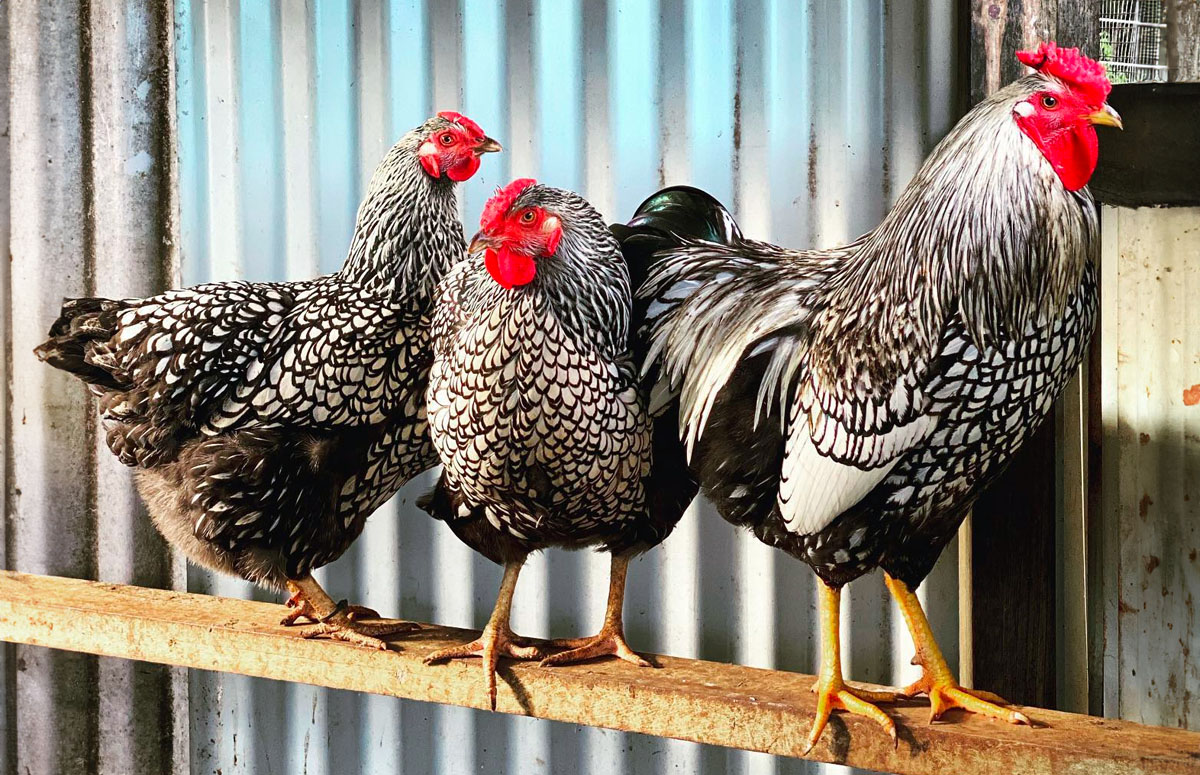
Characteristics | Eggs | Hen vs Rooster | Chicks | Climate | Silver Laced Color Pattern | History | Genetics | Breeding | Personality
The Silver Laced Wyandotte is an iconic variety of the Wyandotte chicken breed with silvery-white plumage and dark, intricate lacing, giving it a truly remarkable look and royal presence. The Silver Laced Wyandotte is more than just a chicken – it’s a living work of art. But their charm doesn’t stop at their looks: Silver Laced Wyandottes are docile, great egg layers, and quick to mature.
Let’s take a closer look at the Silver Laced Wyandotte’s unique traits, including the black scalloped pattern in their plumage, their genetics, how to sex them, a little bit of history, and breeding challenges.
Characteristics
Silver Laced Wyandottes (SLW) have silvery-white ground color plumage, with each feather featuring a single black stripe that tapers to a fine point at the end.
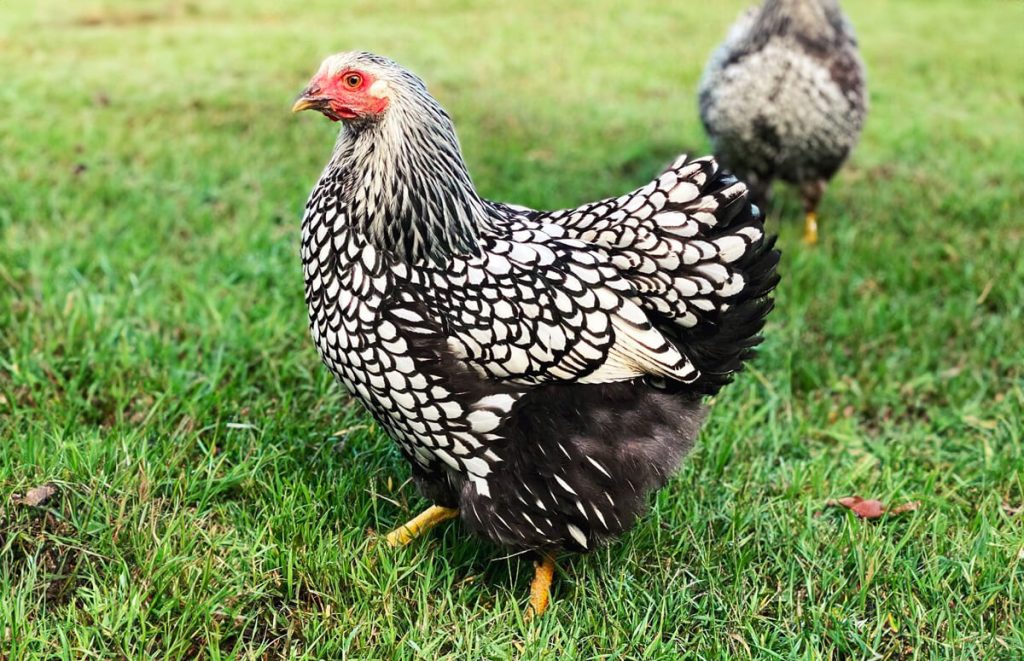
Like the other birds in the Wyandotte chicken family, the Silver Laced birds are rather large and rounded. Silver Laced Roosters tip the scale at 8 pounds (3,6kg), and Silver Laced hens weigh around 6.5 pounds (2,9kg). The Silver Laced Wyandotte variety also has an APA-recognized bantam miniature version of roughly 3.3 pounds (1,5kg).
| Eggs | 200 eggs/year |
| Egg Color | Brown |
| Egg Size | Large |
| Weight | 6.5 – 8 lbs |
| Hardiness | Cold Hardy |
| Temperament | Friendly but assertive |
| Beginner-friendly | Yes |
| Color | Silver with black lacing |
Silver Laced Wyandottes have a rose comb on their rather broad skull. Their legs are clean and yellow-skinned. Wattles, earlobes, and faces are red. The beaks are dark golden, and the eyes are yellow.
Like all Wyandottes, they have nice, full, and rounded breasts, which makes them great meat chickens next to their excellent egg-laying capabilities.
Eggs
A Silver Laced Wyandotte chicken is a dual-purpose breed and a decent egg layer. The hens lay about four large cream to brown eggs per week, or more than 200 eggs yearly.
In the winter, they usually slow down or stop laying, but if you add extra light, these cold-hardy birds tend to keep laying eggs. The only time Silver Laced Wyandottes stop laying eggs is during molting.
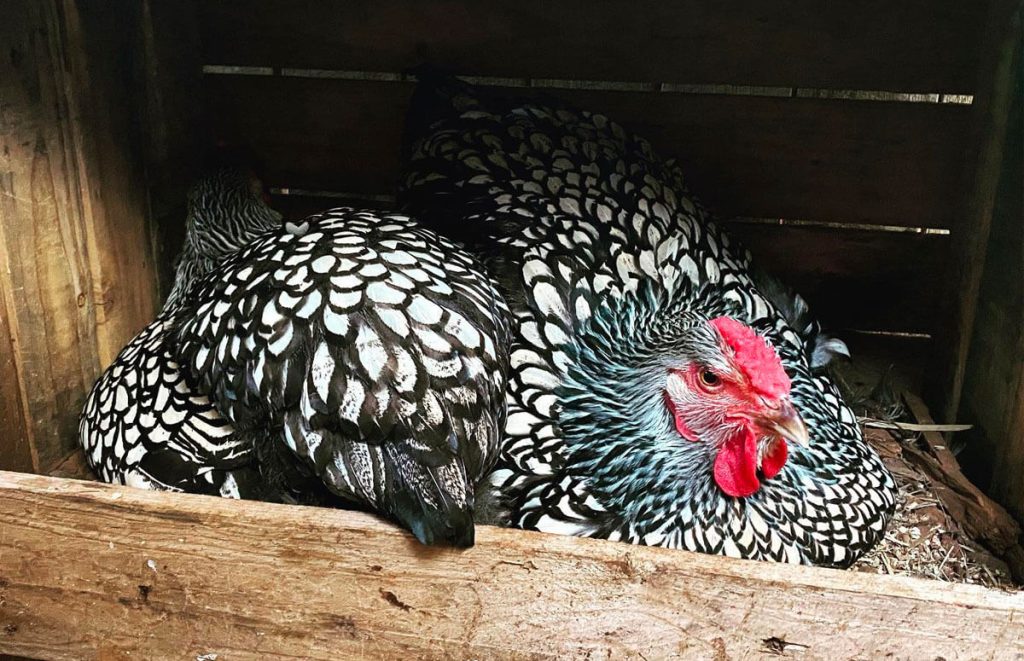
Oftentimes Silver Laced Wyandotte hens tend to go broody, which can also cause them to stop egg production.
Pros and Cons of the Silver Laced Wyandotte
The Silver Laced Wyandotte is a breed cherished by many chicken keepers, but it has pros and cons. Let’s address the most ones.
On the positive side, these chickens excel in cold climates. They are equipped with small rose combs and fluffy bodies, which make them remarkably self-reliant and resilient to chilly temperatures. Additionally, their striking silver-white and black laced plumage adds an ornamental touch to any flock, making them a popular choice among poultry enthusiasts. The dual-purpose nature of this breed, known for both egg production and meat quality, enhances its practical appeal. Silver Laced Wyandottes are also excellent foragers, reducing the need for excessive feeding.
However, this also means they need more space than most other breeds. Next to that, despite their cold-hardy nature they do not fare well in warmer climates. Additionally, Silver Laced Wyandottes are a dominant breed, which can result in conflicts if you keep a mixed flock. It’s best not to keep them together with submissive breeds like Silkies or Faverolles.
Pros
- Cold-hardy
- Excellent foragers
- Dual purpose breed
- Beautiful colors
- Don’t need much extra care
Cons
- Need more space
- Dominant breed
- Don’t do well in warm climates
Silver Laced Wyandotte Hen vs Rooster
Both Silver Laced hens and roosters have the iconic silvery-white and black laced plumage. They share several features, such as the silvery-white head, dark slate undercolor, black fluff, and a green luster in the back plumage sections. Young birds can be challenging to distinguish.
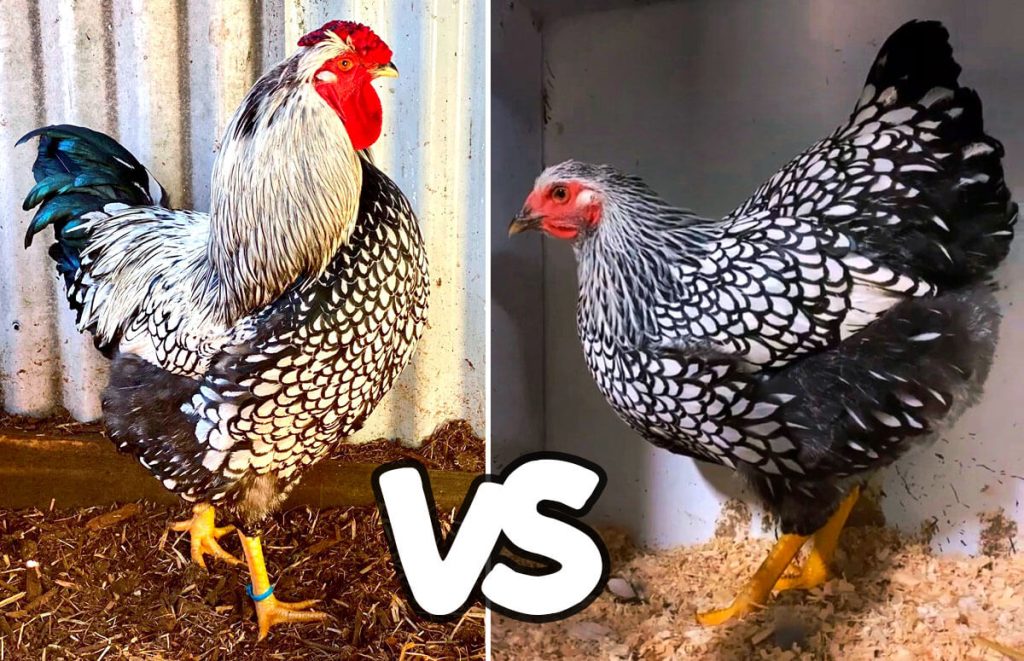
Roosters grow faster and have slightly more prominent and redder wattles and combs. Those of the hens tend to be more pink. The roosters are also sturdier and have longer legs.
| Feature | Silver Laced Rooster | Silver Laced Hen |
|---|---|---|
| Weight | 8 lbs | 6.5 lbs |
| Back | Pointed saddle feathers | Rounded feathers |
| Plumage | Patchy (cockerels) | Uniform lacing (pullets) |
| Tail Feathers | Long sickles, pointed, no lacing | Laced, shorter, rounded on the edges |
| Tail Coverts | Black with green luster | Black with a white center in each feather |
| Comb, Wattles | Big, red | Small, pink |
| Body | Large and broad with long legs | Smaller, shorter legs |
The silver lacing pattern can also give some clues. Silver Laced Wyandotte roosters have pointed saddle feathers and don’t have laced tail feathers. Rooster have black tail coverts with a green luster, while the hens have a black tail with black coverts having some white in the feathers.
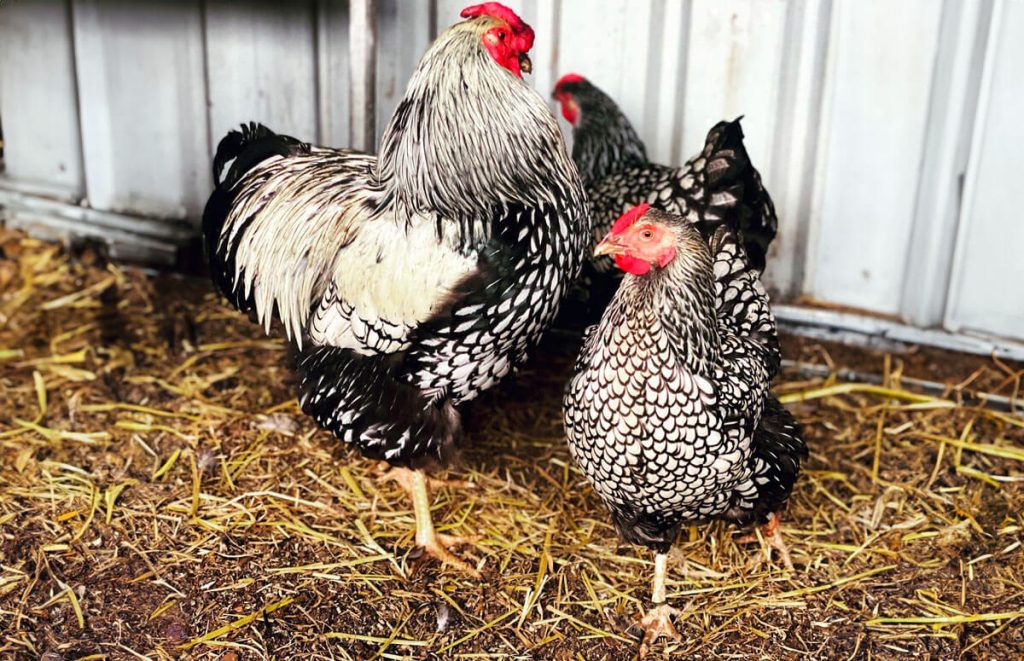
Young cockerels don’t have a pronounced plumage and can look patchy. Pullets have a pretty uniform lacing.
You can distinguish the gender in Silver Laced Wyandottes definitively by the age of 5 months.
Chicks
Silver Laced Wyandotte chicks have various patterns in their down. Some are almost completely black, while others will be silvery gray. Most chicks have dark stripes on their back.
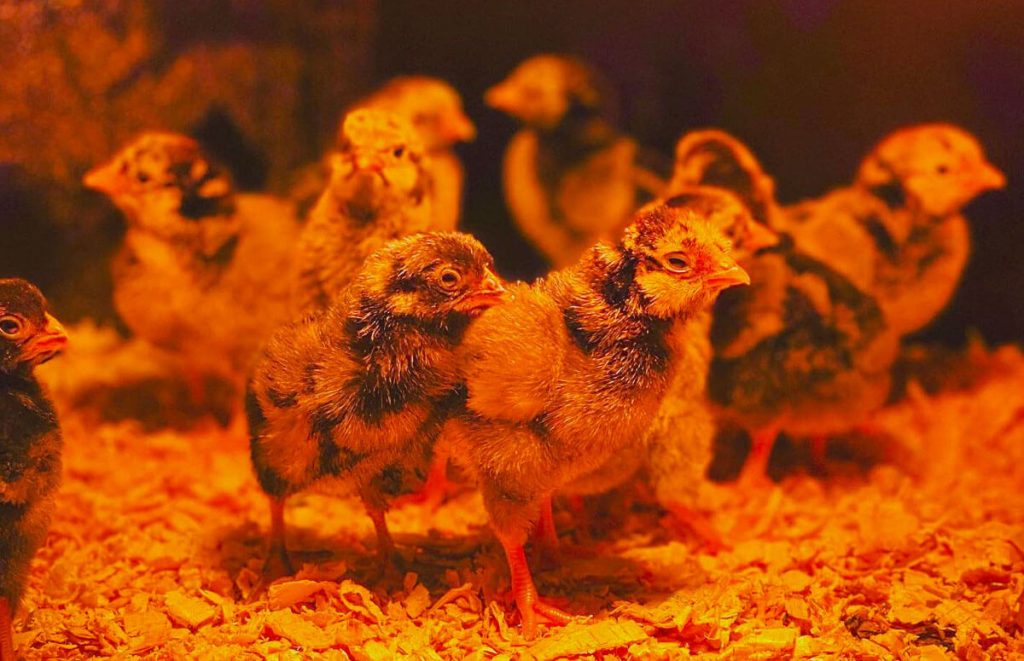
When they hatch, you can immediately see the yellow shanks and beaks. The down of Silver Laced Wyandotte hatchlings can also show some yellow coloring, as you can see in this photo.
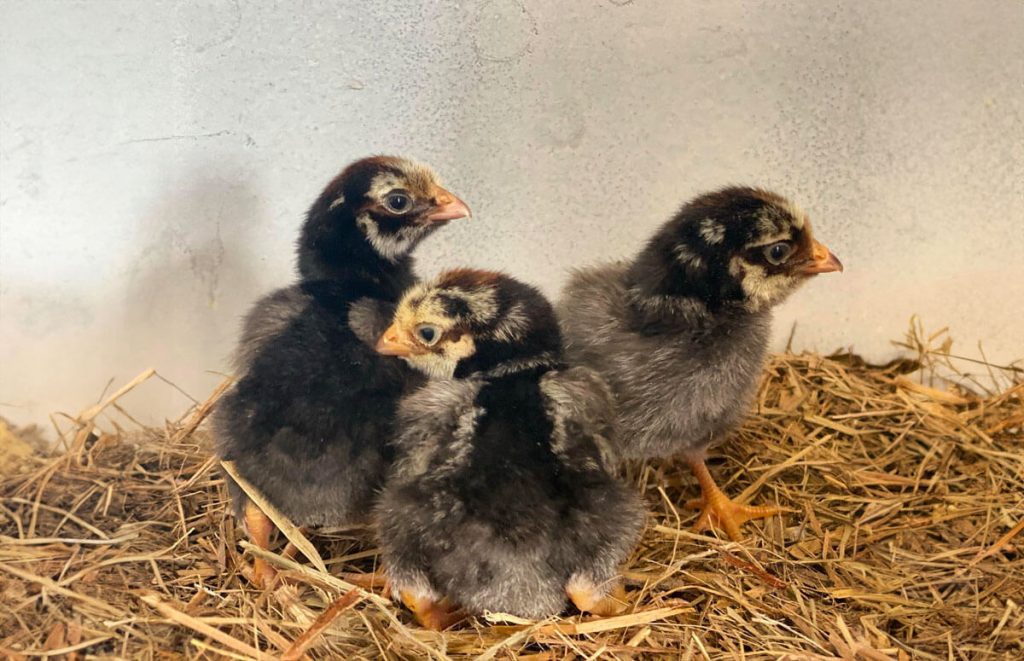
Silver Laced Wyandotte chicks are not sex-linked, so you can’t tell whether they are female or male at first. It takes a couple of months to identify the gender. When they grow up, the cockerels generally look more patchy, while the pullets have a uniform pattern.
In general, Wyandotte hens are excellent mothers for their chicks.
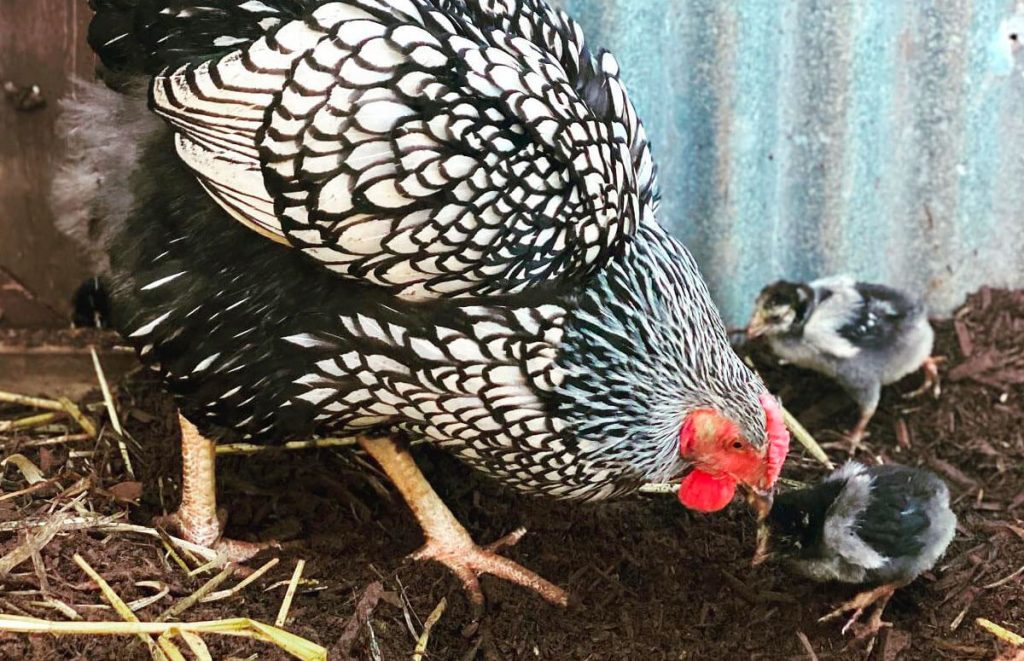
Climate
Silver Laced Wyandottes are the first variety of Wyandottes and have especially been bred since 1870 to stand cold American winters. Their small rose comb and fluffy body help them stand the cold and prevent frostbite.
However, just because they are black and white does not mean they are penguins, either. Their combs and wattles can still suffer from frostbite.
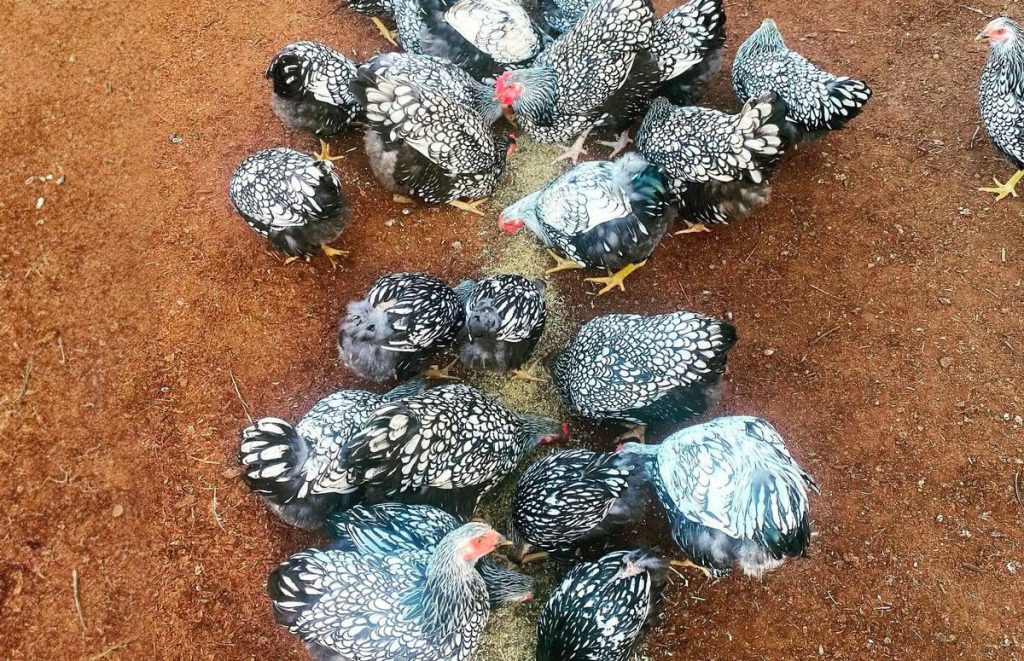
The other side of the medal is that Silver Laced Wyandottes don’t like tropical temperatures.
So when dealing with a heat wave, always keep them cool. Wyandottes are not the best breed to be kept in a Mediterranean or southern climate because of their body structure and comb size. They’ll quickly overheat and suffer heat stress.
The Silver Laced Color Variety
The Silver Laced variety is just one of the many color varieties of Wyandottes. And when it comes to different types of Wyandotte chickens, things can get pretty complex pretty fast.
While there are only ten official varieties in The Standard of the American Poultry Association, the Europeans have thirty colors listed.
In general, Wyandottes come in three groups:
- Laced Wyandottes: silver laced, gold laced, blue laced, …
- Marked Wyandottes: black-white Columbia, Silver Penciled, …
- Single-colored Wyandottes: white, blue, black, buff, …
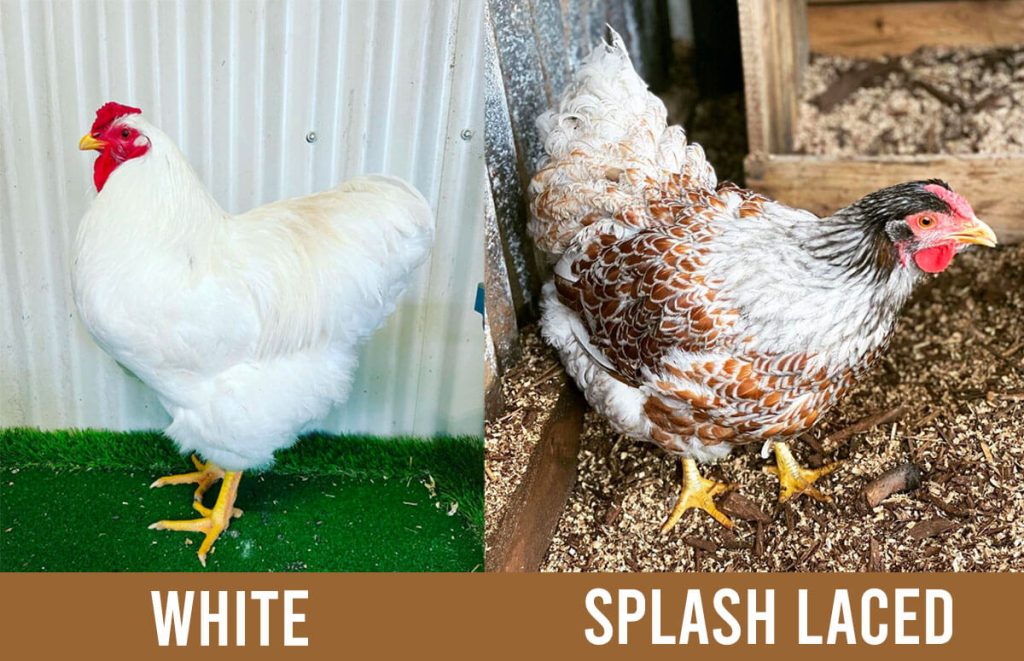
The Silver Laced Wyandotte is a pure white bird with a black edge to its feathers. This usually translates to a Black Laced Silver/White in European languages. The Silver Penciled Wyandotte has multiple nested lines instead of single lacing, which results in an entirely different pattern.
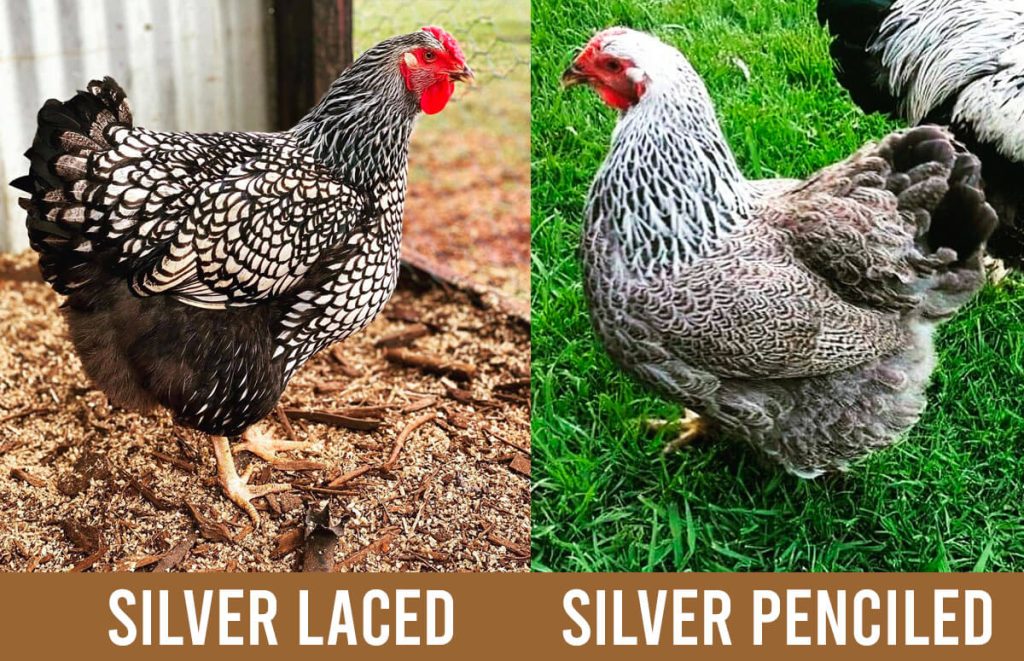
A Golden Laced Wyandotte is a gold bird with black lacing. The hens are mahogany brown.
While Silver Laced Wyandottes have white bodies and Gold Laced Wyandottes have a brown ground color, the Blue Laced variants don’t have a blue (greyish) body. Only their lacing is blue, which makes things utterly confusing.
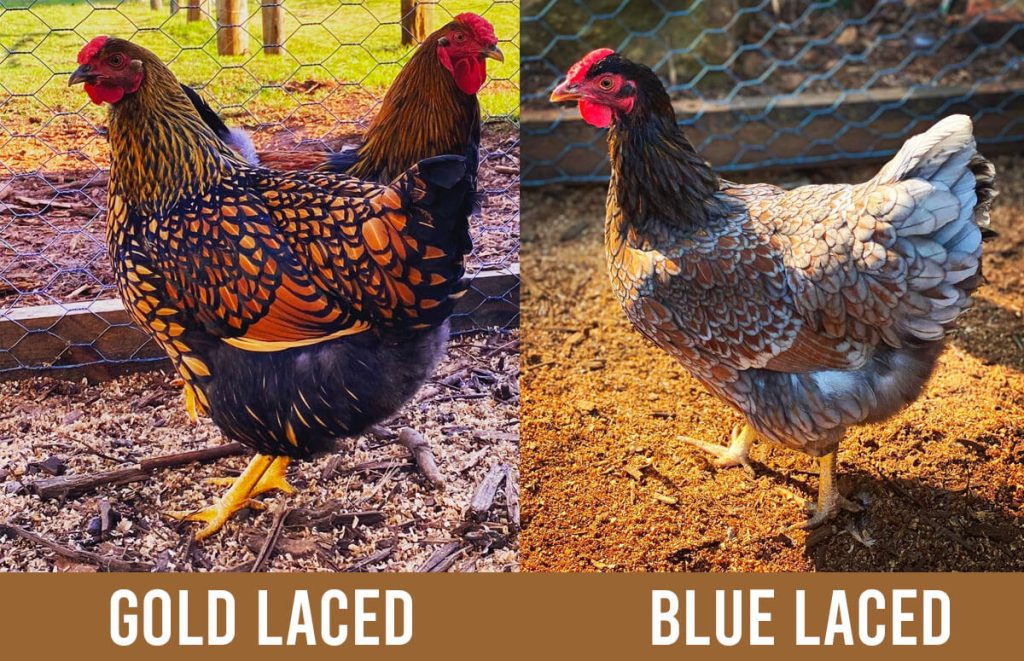
The Blue Laced Silver Wyandotte is sometimes called a Blue Silver Laced Wyandotte or Violette. Its color pattern is similar to the Silver Laced Wyandotte, but the lacing is greyish blue rather than black.
If we take one step further down the rabbit hole, there is also the Splash Laced Silver Wyandotte. This is the same as the Blue Laced Silver Wyandotte, but these birds have two copies of the Blue-gen. This fades away almost all of the black lacing, which turns the birds almost white.
History of the Silver Laced Wyandotte
The Wyandotte chicken was created in the United States during the 1870s by four breeders: H. M. Doubleday, John Ray, L. Whittaker, and Fred Houdlette. The Silver Laced Wyandotte was the first official color variation, gaining recognition in the American Standard of Perfection in 1883.

At the same time, the Wyandotte chicken breed crossed the Atlantic and made its way to Britain, garnering admiration on both sides of the ocean.
The first breed varieties went by various names referring to black-and-white Sebrights, like Sebright Cochin or American Sebright. The name ‘Wyandotte’ was introduced in 1883, taking inspiration from a Native American tribe that inhabited upstate New York and Ontario regions.
The origin of the Silver Laced Wyandotte remains a mystery, but according to Livestock Conservancy, it is believed to result from breeding efforts involving spangled Hamburgs and dark Brahmas. The Hamburg’s contribution is seen in the breed’s rose comb, making them well suited for colder climates.
Silver Lace Genetics
Basically, the pattern is the result of two effects:
- the silvery-white ground color
- the black lacing
The Silver Laced Wyandotte is white because its DNA contains the Silver gene (S). This sex-linked gene is located on the Z chromosome. Roosters carry two copies of the S-gene, hens only one. So a Silver Laced Rooster can carry some gold (suppressed by the S-gene), but a hen can’t hide any gold if it’s white.
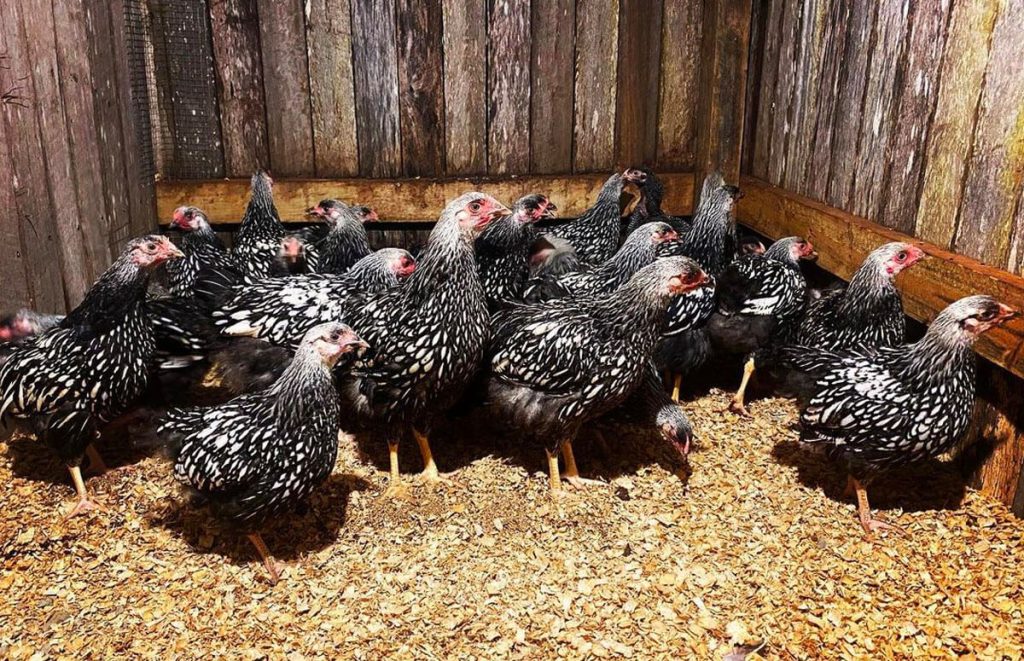
The black lacing does not result from a single gene but originates from the intricate interplay of multiple genes that shift the black pigment in the feather:
- Pattern Gene (Pg): the pattern gene creates lines, but with Pg alone, the rim of the feather would not be black, and the feathers would have concentric penciling
- Melanotic (Ml): this gene makes the lines broader and causes them to shift toward the edge of the feather
- Columbian (Co): removes the inner laces and creates single-lacing
Breeding the Silver Laced Wyandotte
Silver lacing was the first color in the standards and is still the most common among breeders today.
One of the advantages is that Silver Laced Wyandottes breed true. If you cross a Silver Laced Hen and Silver Laced Rooster, the offspring will also be Silver Laced. This is not the case for other variants, like the Blue Laced Red, as the blue gene does not breed true.
Breeding Challenges
Silver Laced Wyandottes often captivate novices at exhibitions, where breeders and judges frequently engage in conversations beside the bird cages. Although widely bred nowadays, they are relatively infrequently showcased, as it’s difficult to get the color and lacing perfect.
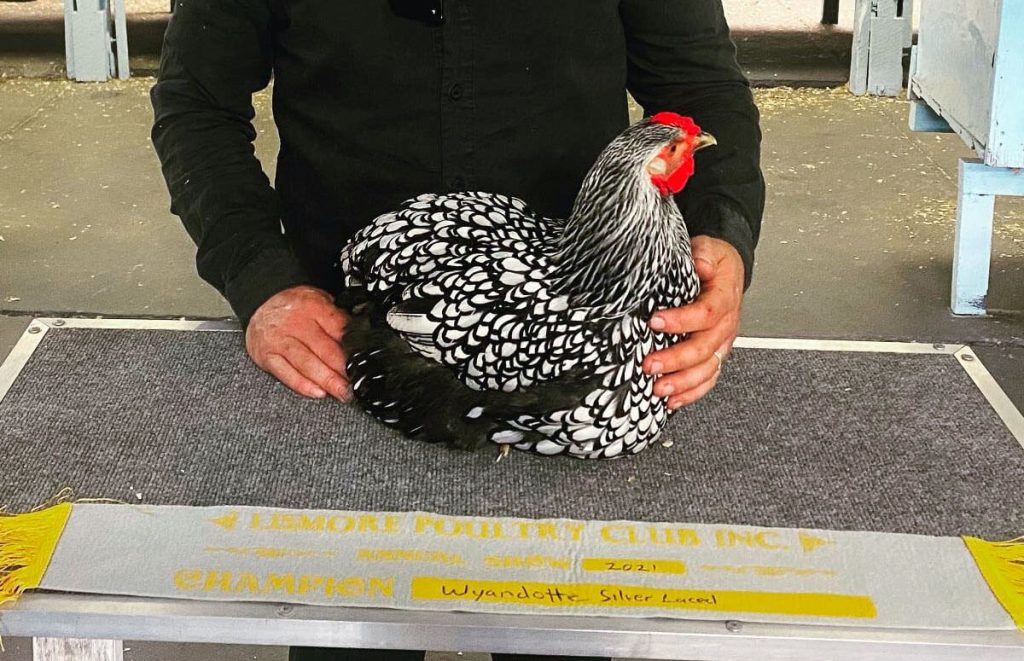
It can be challenging to get the characteristic curved lines and roundness due to a harder and somewhat longer feather structure. Oftentimes, many breeding cycles are needed to get a uniform and beautiful lacing around the inner field of the feather.
However, silver is easier to breed than gold, where you have to balance the gold color to prevent it from being too light, making black lacing stand out, or too dark, which results in a mahogany-like color.
Silver Laced Wyandottes Crosses
Since Laced Wyandottes are so popular as show birds, many people are breeding Silver Laced Wyandottes and creating all kinds of standard and non-standard color varieties. One of the most common is the cross with the Gold Laced Wyandotte.
- the Gold Laced Wyandotte was created in 1880 from a Silver Laced Wyandotte by Joseph McKeen. He used Silver Laced Wyandotte females with a sizable fowl known as the Winnebago, which exhibited a Black Red pattern. His variety was recognized by the American Standard in 1888 and swiftly earned a reputation.
Crossing a Silver Laced Wyandotte with a Gold Laced Wyandotte
The Gold Laced Wyandotte has a gold ground color with black lacing. In this cross, the results are all about the Silver gene. The Silver gene makes the ground color white. Birds without Silver look gold.
The silver gene is sex-linked on the Z chromosome of a chicken. Roosters have two Z-chromosomes (ZZ), and hens only have one (ZW). Silver is dominant, so if a Rooster has a single copy (S s+), it will be white.
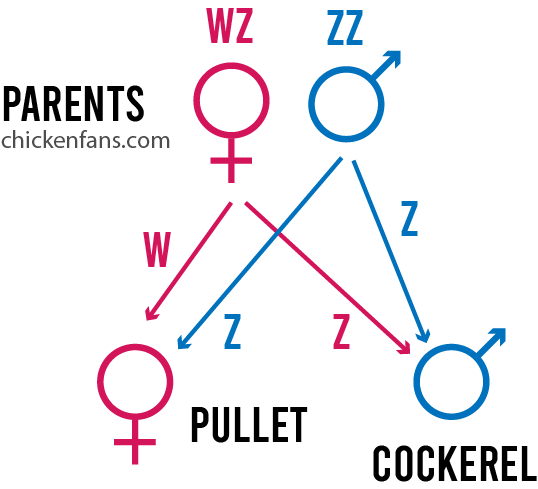
The following table lists all the possible outcomes for the cockerels and pullets in the offspring, when you cross a Silver Laced Wyandotte with a Gold Laced bird.
| Rooster | Hen | Rooster Offspring | Hen Offspring |
|---|---|---|---|
| Gold Laced (s+s+) | Silver Laced (S-) | Silver Laced (Ss+) | Gold Laced (s+-) |
| Silver Laced (SS) | Gold Laced (s-) | Silver Laced (Ss+) * | Silver Laced (S-) |
| Silver Laced carrying Gold (Ss+) | Gold Laced (s+) | Silver Laced (Ss+) * Gold Laced (s+s+) | Silver Laced (S-) Gold Laced (s+-) |
| Silver Laced carrying Gold (Ss+) | Silver Laced (S-) | Silver Laced (SS) Silver Laced (Ss+) * | Silver Laced (S-) Gold Laced (s+-) |
Bear in mind: if you have a Silver Laced Wyandotte Rooster, you can’t see if it is pure silver (SS) or carrying Gold (Ss+). Only the parents can tell you.
One thing to note for breeders is that the Silver gene (S) exhibits incomplete dominance over wild-type (s+). The Silver-gene allows partial expression of red pigments. Roosters with Ss+ will, therefore, leak some yellow or buff in the breast and shoulder areas. The extent of yellow coloring depends on modifying genes and the individual genetics of your bird.
Crossing a Silver Laced Wyandotte with Other Varieties
If you cross a Silver Laced Wyandotte with other color varieties besides the Gold Laced, you will get an interplay of the different genes:
- Blue Laced Red Wyandotte: adding the Blue gen into the mix will dilute the black lacing to blue or splash. The offspring will have all kinds of colors.
- Columbian Wyandottes: the Columbians don’t have the Ml-gene, the offspring will mostly have incomplete lacing and all kinds of issues
- Silver Penciled Wyandottes: the silver penciled wyandottes are genetically Silver Laced Wyandottes that lack the Columbian gen (Co). It’s the Co-gen that turns the penciling into single lacing. Offspring will be mixes of double lacings, and some will look Columbian.
- Buff Wyandottes: combining the Buff Wyandotte gene pool with a Silver Laced will give many different colors and patterns (e.g. half spangled, transv. pencilled, etc.)
Personality
Silver Laced Wyandottes are generally tame and have a calm, friendly nature like other Wyandottes. They are kind to humans and children but a bit too big to be lap chickens.
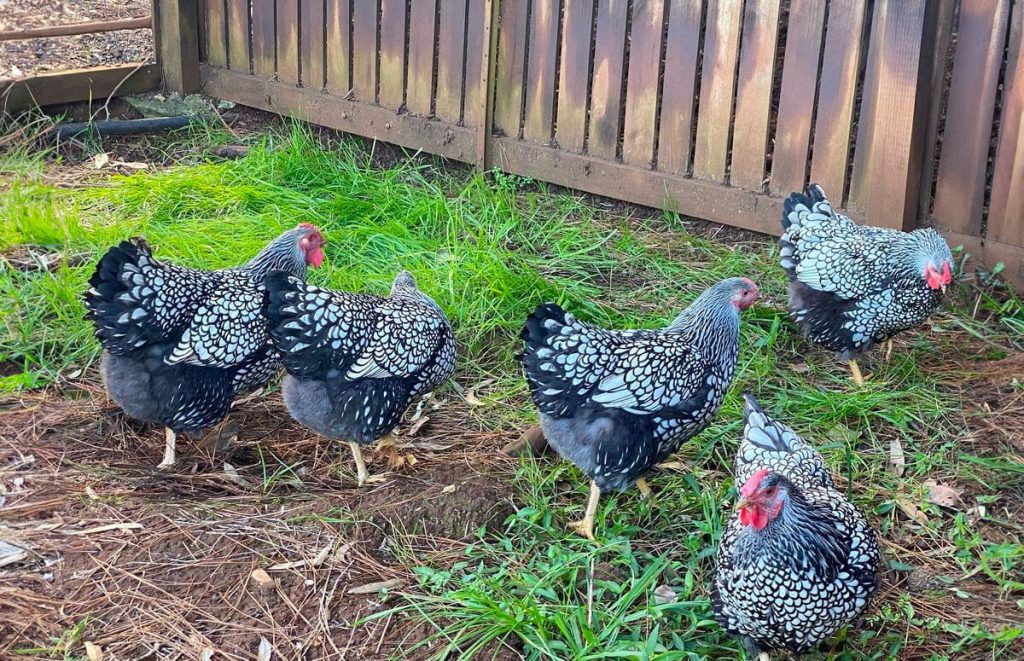
They go well with other birds in the flock, but the roosters can be a bit overwhelming if you are unlucky. Wyandottes are usually high in the pecking order as they are assertive chickens with a little bit of weight.
Related Articles
Here are some of the articles we mentioned:
- Wyandotte Chickens: an overview of the Wyandotte chicken breed and the color varieties
- Silver Penciled Wyandotte: an overview of the Silver Penciled Wyandotte, a variety with a black-and-white pattern that looks very similar to the Silver Laced Wyandotte’s plumage pattern, but gives an entirely different impression
- Golden Laced Wyandotte: a complete guide of the Golden Laced Wyandotte chicken
- Buff Wyandotte: a complete guide of the Buff Wyandotte chicken and buff varieties
- Blue Wyandotte: a complete guide of the Blue Wyandotte chicken and blue varieties
- Blue Laced Red Wyandotte: a comprehensive guide on this interesting variety
- Splash Laced Red Wyandotte: a guide on the Splash Laced Red variety
- Columbian Wyandotte: a striking black and white variety of the Wyandotte chicken
- White Wyandotte: a breed profile of the White Wyandotte
- Sebright Chickens: a chicken breed that has varieties with a similar lacing pattern
- Brahma Chickens: large chicken breed originally used to create the Wyandotte
- Hamburg Chickens: chicken breed used to create the Wyandotte, with similar black and white patterns
- Chicken Feather Guide: to understand the difference between all types of feathers
- Chicken Breeding & Genetics: an overview for chicken breeding and genetics for beginners
If you are considering to get Silver Laced Wyandottes, here are some other resources:
- Chicken Coop Size Calculator: to calculate the size of your coop
- Chicken Raising Guide: general chicken raising guide
Credits for the photos go to Cactus Hill Poultry breeders, specializing in breeding silver-laced wyandottes.






















